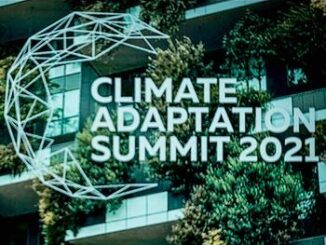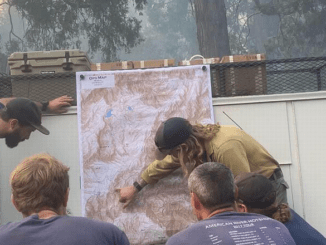
BRUSSELS, Belgium, May 3, 2021 (ENS) – A giant gap between the amount of greenhouse gases countries report emitting and the amount of these heat-trapping gases independent scientists estimate from global models that the countries actually emit, a scientific team led by researchers of the European Commission’s Joint Research Centre has found.
The main issue is that there appears to be a “conceptual discrepancy between model estimates and country reporting,” the JRC researchers said.
As a fix, the JRC scientists are proposing a method for improving the assessment of the world’s collective progress towards the Paris Agreement’s goal of limiting the global temperature increase to two degrees Celsius (2°C) above preindustrial levels.
“There is a gap of 5.5 gigatons of CO2, which is a huge gap,” said Giacomo Grassi, a forest expert at the European Commission’s Joint Research Centre, and lead author of the study just published in the journal “Nature Climate Change.”
The size of this difference equals around 5.5 billion tons of CO2 emissions. Grassi says this gap is “quite new,” but he and his colleages have been working on this problem since at least 2017.
“Tracking the mitigation potential of forests requires more confidence in numbers, including reconciling estimates between country reports and scientific studies. However, the credibility of land-based mitigation may be hampered by large uncertainties in the way countries consider mitigation and their GHG estimates,” Grassi said in 2017 after publishing a separate paper calling for “robust, transparent and credible data” to track the real climate mitigation potential of forests.
“National GHG inventories must be improved in terms of transparency, accuracy – including information on uncertainties, consistency, completeness and comparability, especially in developing countries,” said Grassi in February 2017.
“There is also an urgency to reconcile the currently relevant differences between the GHG estimates provided in the country reports and those based on scientific assessments,” he said, describing the same problem that still exists today.

In December 2015, 195 countries adopted the Paris Climate Agreement at the 21st Conference of Parties (COP21) of the United Nations Framework Convention on Climate Change, UNFCCC. As part of the process, 187 countries – representing more than 96 percent of global net emissions – submitted their Intended National Determined Contributions, which form the basis for implementing mitigation actions under the climate agreement.
The study published today reconciles the different land-use greenhouse gas estimates by “translating” the results of global scientific models into figures comparable to countries’ greenhouse gas inventories.
The findings of the study are relevant for the global carbon modeling community, including the Intergovernmental Panel on Climate Change, IPCC, and for the Global Stocktake, the periodic assessment of collective climate progress starting in 2022 under the Paris Agreement.
Under the Paris Agreement, countries agreed to keep the increase in global temperature to well-below 2°C relative to pre-industrial times and, to this aim, shall reach a “balance between anthropogenic greenhouse gas emissions and removals in the second half of this century.”
Countries, using national greenhouse gas inventories, monitor national emissions using agreed IPCC methodologies, while global models, called Integrated Assessment Models, use different methods to estimate future emission pathways consistent with the 2°C temperature goal.
Their different approaches have led to different estimates of the forested land removals of carbon dioxide created by anthropogenic activities such as burning fossil fuels, as if they were speaking different languages.
The size of this difference, equaling today around 5.5 billion tons of CO2 emissions, and reducing over time with high-ambition emission reduction scenarios, complicates the task of assessing collective climate progress under the Paris Agreement’s Global Stocktake.
In this process, the collective countries’ greenhouse gas estimates will be compared to what science suggests as necessary to stay to well below 2°C. Speaking the same language, namely having comparable data, is crucial.
The scientists on the study propose a solution – they would calibrate the different assessment languages to make estimates from various countries comparable.
Country greenhouse gas inventories consider a broader forest area than global models, and on this area, they consider some “anthropogenic” fluxes seen in the global models as “natural.”
The new study provides a means to translate the estimates of future land emission pathways developed by global models to figures more comparable with the estimates by countries.
Each approach is valid in its own specific context, yet both have limitations. Since there is no perfect way to estimate the human-caused CO2 sink, what counts most is the transparency and comparability of these estimates, across countries and with global models.
The method in the new study enables comparison between these two different approaches by reallocating part of the forest CO2 removals considered natural by the global models to the anthropogenic component.
The proposed solution does not change the models’ original decarbonization pathways, but recalibrates them to ensure greater comparability with countries’ own greenhouse gas reporting. The JRC study makes the case for strengthening rapid and ambitious global climate mitigation efforts.
Featured Image: The forested valley of the Irati River lies between Navarra in northern Spain and the Atlantic Pyrenees in southwestern France. October 15, 2020 (Photo by Joan Brebo)
© 2021, Environment News Service. All rights reserved. Content may be quoted only with proper attribution and a direct link to the original article. Full reproduction is prohibited.



